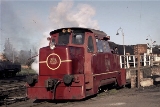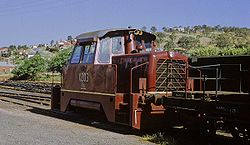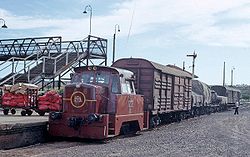
New South Wales X200 class locomotive
Encyclopedia
The X200 class were a group of rail tractors introduced in 1968 and operated by the New South Wales Government Railways
of Australia
. They were a development of the smaller and less numerous X100 class
. The X200 class remained in NSWGR service until 1990 when they were either withdrawn or sold off to private companies, and many remain operational today.
They were built using a number of steam locomotive spare parts. They were built on the inner bogie
s of the AD60 Beyer-Garratt class
locomotives, and used spare C36 class 4-6-0 express locomotive windows in their cabs. Their engines were rated at 260 hp at 2,100 rpm and had a top speed of 24 mph. The rounded shapes of the hoods and cab gave it a baby-brother appearance to the main line 42
and 44 classes
then in use. The addition of a train brake allowed them to be run on the main line and also to be used as replacements for various ageing shunting locomotives. The six members of the X200 class Mk.1 variant were initially used in the Sydney metropolitan network, but did later find their ways beyond this region.
They were built on the outer bogies of the AD60 Beyer-Garratt class locomotives. Their engines were more powerful rated at 290 hp at 2,100 rpm and they had a higher top speed of 32 mph. This made them more practical for light line use. One was even rostered on to the Yass Tramway, previously the domain of the Z13 class 4-4-2 suburban tank locomotives. (The Z13 class were called back to Yass during winter months to provide heating in the train and they also filled in when the X200 had "failed"). The exterior design of the Mk.2 variant was more squarish, giving it the appearance of a baby-brother to the 49 class
diesel locomotives introduced in 1960.
Despite differences in engine horsepower ratings, both variants were rated as having a tractive effort of 17750 lbf (79 kN). This was more powerful than many of the typical small and workshop steam shunting locomotives of the time.
The X200 class must be considered largely successful, as they began to replace the various ageing steam shunting locomotives in various depots of the time. They were cleaner, more efficient to run, requiring less maintenance, and also giving locomotive crews more comfortable working conditions. Another indicator of the class' success is that several examples are still operational even today, at an age of around 45 years! Unfortunately, with the volatile and ever-changing nature of rail transport companies in the modern day, it is hard to keep a 100% accurate listing of their current owners and operational areas.
There is a certain amount of confusion with the numbering in this class. The numbers specified above apply to the class when first issued to traffic. In later years a certain amount of number-swapping was carried out by workshops. The biggest confusion being X101 and X212 swapping numbers, being two completely different types of locomotive! X217 and X218 later became X117 and X118, confusing the matter further. It appears that members of the X200 class were indiscriminately re-numbered into the X100 series. Many other renumberings exist. For the purposes of research it is often easier to refer to individual locomotives by their numbers when first issued to traffic and to note any number changes in brackets as below.


New South Wales Government Railways
The New South Wales Government Railways was the government department that operated the New South Wales Government's railways until the establishment of the Public Transport Commission in 1972. Although later known officially as the Department of Railways, New South Wales, it was still generally...
of Australia
Australia
Australia , officially the Commonwealth of Australia, is a country in the Southern Hemisphere comprising the mainland of the Australian continent, the island of Tasmania, and numerous smaller islands in the Indian and Pacific Oceans. It is the world's sixth-largest country by total area...
. They were a development of the smaller and less numerous X100 class
New South Wales X100 class locomotive
The X100 class is a group of diesel locomotive built and operated by the New South Wales Government Railways of Australia.-History:A need existed for a small shunting unit that could handle the requirements at the smaller junction marshalling yards, larger intermediate stops and the workshop needs...
. The X200 class remained in NSWGR service until 1990 when they were either withdrawn or sold off to private companies, and many remain operational today.
Mk.1 series
The first series of the X200 class (now distinguished as the Mk.1 variant) were larger and more powerful, being 3 times more powerful and twice as heavy as the X100 class. Only 6 examples were ordered and produced of the Mk.1 variant. They were numbered X201-X206.They were built using a number of steam locomotive spare parts. They were built on the inner bogie
Bogie
A bogie is a wheeled wagon or trolley. In mechanics terms, a bogie is a chassis or framework carrying wheels, attached to a vehicle. It can be fixed in place, as on a cargo truck, mounted on a swivel, as on a railway carriage/car or locomotive, or sprung as in the suspension of a caterpillar...
s of the AD60 Beyer-Garratt class
New South Wales AD60 class locomotive
The AD60 class was a class of steam locomotives operated by the New South Wales Government Railways in Australia. They were built with the 4-8-4+4-8-4 wheel arrangement. They are commonly considered the most powerful Australian steam locomotives although the NSWGR 57 class was actually slightly...
locomotives, and used spare C36 class 4-6-0 express locomotive windows in their cabs. Their engines were rated at 260 hp at 2,100 rpm and had a top speed of 24 mph. The rounded shapes of the hoods and cab gave it a baby-brother appearance to the main line 42
New South Wales 42 class locomotive
The 42 class locomotives were built by Clyde Engineering at Granville, New South Wales for the New South Wales Government Railways between 1955 and 1956. Six locomotives were built numbered 4201–4206...
and 44 classes
New South Wales 44 class locomotive
The New South Wales 44 class locomotives were one of the first locomotives built by A. E. Goodwin in the Alco tradition. One-hundred of these DL500B units were built. Introduced in 1957, these locomotives have served every part of NSW, from services in the North and South, to the Indian Pacific...
then in use. The addition of a train brake allowed them to be run on the main line and also to be used as replacements for various ageing shunting locomotives. The six members of the X200 class Mk.1 variant were initially used in the Sydney metropolitan network, but did later find their ways beyond this region.
Mk.2 series
The second series of the X200 class (now distinguished as the Mk.2 variant) were different again. There were 12 examples of the Mk.2 type being numbered X207-X218.They were built on the outer bogies of the AD60 Beyer-Garratt class locomotives. Their engines were more powerful rated at 290 hp at 2,100 rpm and they had a higher top speed of 32 mph. This made them more practical for light line use. One was even rostered on to the Yass Tramway, previously the domain of the Z13 class 4-4-2 suburban tank locomotives. (The Z13 class were called back to Yass during winter months to provide heating in the train and they also filled in when the X200 had "failed"). The exterior design of the Mk.2 variant was more squarish, giving it the appearance of a baby-brother to the 49 class
New South Wales 49 class locomotive
The 49 class were branchline diesel-electric locomotives order by and operated by the New South Wales Government Railways, similar to the 48 and 47 classes. When they were ordered from Clyde Engineering at Granville, New South Wales they were ordered in 3 batches, each of six locomotives: 4901 to...
diesel locomotives introduced in 1960.
Despite differences in engine horsepower ratings, both variants were rated as having a tractive effort of 17750 lbf (79 kN). This was more powerful than many of the typical small and workshop steam shunting locomotives of the time.
Summary
| Type | Power |
|---|---|
| X200 Rail Tractor | 17,750 lbf |
| Z13 (4-4-2T) | 13,000 lbf |
| Z18 (0-6-0T) | 11,550 lbf |
| X10 (F351 2-4-0T) | 9,090 lbf |
| X1044 | 6,050 lbf |
| X1046/X1047 | 12,540 lbf |
| X10 (7-ton luffing crane) | 14,900 lbf |
The X200 class must be considered largely successful, as they began to replace the various ageing steam shunting locomotives in various depots of the time. They were cleaner, more efficient to run, requiring less maintenance, and also giving locomotive crews more comfortable working conditions. Another indicator of the class' success is that several examples are still operational even today, at an age of around 45 years! Unfortunately, with the volatile and ever-changing nature of rail transport companies in the modern day, it is hard to keep a 100% accurate listing of their current owners and operational areas.
There is a certain amount of confusion with the numbering in this class. The numbers specified above apply to the class when first issued to traffic. In later years a certain amount of number-swapping was carried out by workshops. The biggest confusion being X101 and X212 swapping numbers, being two completely different types of locomotive! X217 and X218 later became X117 and X118, confusing the matter further. It appears that members of the X200 class were indiscriminately re-numbered into the X100 series. Many other renumberings exist. For the purposes of research it is often easier to refer to individual locomotives by their numbers when first issued to traffic and to note any number changes in brackets as below.
Remaining examples
If renumbered, original number is first, and new numbers in brackets.

Preserved
- X204 (now X104) and X214 are preserved at the Dorrigo Steam Railway and MuseumDorrigo Steam Railway and MuseumThe Dorrigo Steam Railway and Museum in Dorrigo, New South Wales, Australia is a large, privately owned collection of preserved railway vehicles and equipment from the railways of New South Wales, covering both Government and private railways...
- X203 is at the ARHS Yass Railway Museum
- X213 belongs to the Coffee Pot Group
- X215 (now X115) is with the Hunter Valley Railway TrustHunter Valley Railway TrustThe Hunter Valley Railway Trust is a railway museum located in North Rothbury, New South Wales Australia on the site of the Rothbury Riot...
In service
- X206 (now XT106i) - Railfleet Services
- X207 - Sold to Specialised Container TransportSpecialised Container TransportSCT Logistics is an interstate transport company in Australia, with facilities in Melbourne, Adelaide, Parkes, and Perth. The company was founded in 1974.- History :...
- X208 - Sold to CRT Group
- X209 - Sold to Specialised Container Transport
- X212 (now X101) - Sold to Specialised Container Transport
- X216 - Sold to Specialised Container Transport
- X217 (now X117) - Sold to QR InterailInterailInterail is an Australian rail freight operator based in Casino, New South Wales.-Creation:Interail was launched on May 31, 2002, as the interstate running arm of Queensland Rail, entering railway operations in New South Wales with the acquisition of Northern Rivers Railroad...
- X218 (now X118) - Sold to CRT Group

